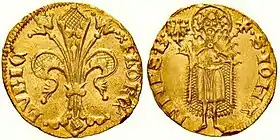Guilder
Guilder is the English translation of the Dutch and German gulden, originally shortened from Middle High German guldin pfenninc "gold penny". This was the term that became current in the southern and western parts of the Holy Roman Empire for the Fiorino d'oro (introduced 1252). Hence, the name has often been interchangeable with florin (currency sign ƒ or ƒl.).

Early versions
The term gulden was used in the Holy Roman Empire during the 14th to 16th centuries in generic reference to gold coins. Currency became more standardized with the imperial reform of 1559. In the early modern period, the value of a gulden was expressed in standardized form (Rechnungsgulden), and in some instances, silver coins were minted designed to have the value corresponding to one gulden. The Rhenish gulden (florenus Rheni) was issued by Trier, Cologne and Mainz in the 14th and 15th centuries. Basel minted its own Apfelgulden between 1429 and 1509. Bern and Solothurn followed in the 1480s, Fribourg in 1509 and Zürich in 1510, and other towns in the 17th century, resulting in a fragmented system of local currencies in the early modern Switzerland.
Modern currencies
With increasingly standardized currencies in the early modern period, gulden or guilder became a term for various early modern and modern currencies, detached from actual gold coins, in the 17th and 18th centuries.
The Netherlands Indies gulden was introduced in 1602, at the start of the United East Indies Company. The Dutch guilder originated in 1680 as a 10.61 g (0.374 oz) silver coin with a silver purity of 91.0%, minted by the States of Holland and West Friesland.[1]
The British Guianan guilder was in use in British Guiana, 1796 to 1839.
In 1753, Bavaria and Austria-Hungary agreed to use the same conventions. The result was the Austro-Hungarian gulden (Austrian Empire 1754 to 1892), and the Bavarian gulden (1754 to 1873, see also Baden gulden, Württemberg gulden, South German gulden).
A Danzig gulden was in use 1923 to 1939.
The Dutch guilder remained the national currency of the Netherlands until it was replaced by the euro on 1 January 2002. The Netherlands Antillean guilder is currently the only guilder in use, which after the dissolution of the Netherlands Antilles remained the currency of the new countries Curaçao and Sint Maarten and (until 1 January 2011) the Caribbean Netherlands.
The Caribbean guilder is a proposed currency for Curaçao and Sint Maarten.
See also
Other coin names that are derived from the gold of which they were once made:
- Öre, øre
- Złoty (historically the Polish equivalent of German gulden)
- Hungarian forint (historically the Hungarian equivalent of Florentine florin)
References
- Krause, Chester; Clifford Mishler (2003). [Standard Catalog of World Coins, 1601-1700: Identification and Valuation Guide 17th Century (Standard Catalog of World Coins 17th Century Edition 1601-1700)] (3rd ed.). Krause Publications. p. 932. ISBN 0-87349-666-3.
